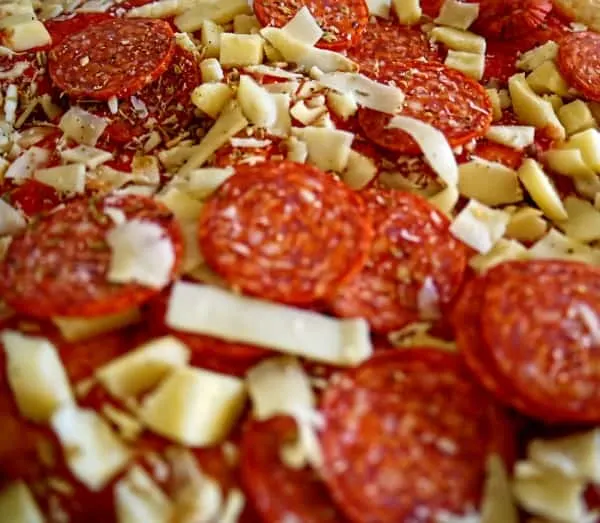Homemade pizza and calzone often include pepperoni, but there are dozens of other recipes that call for this fatty meat too. And most recipes call for only a few slices, so if you’ve bought the whole stick, there will be leftovers.
If you’re a first-time pepperoni buyer, you’re probably wondering for how long is that sausage good for once opened.
Or maybe you’re gathering ingredients for your New York style pizza, and while shopping you noticed that some pepperoni sticks are sold refrigerated, while others don’t. And now you’re unsure if one is better than the other, or if maybe that unrefrigerated pepperoni is simply mishandled. Does unopened pepperoni require refrigeration?
These are all valid questions, as pepperoni isn’t as straightforward when it comes to storage, spoilage, and shelf life as one would like it to. So if you want to learn about why some pepperoni needs to be chilled and other doesn’t, or how to deal with sticks versus sliced pepperoni, you’re in the right place.
To start things off, let’s talk about going bad. That’s usually the first thing readers of this site want to know, so let’s get going.

Can Pepperoni Go Bad? How To Tell If Pepperoni Is Bad?
Like all meat, pepperoni can go bad. But since pepperoni is made from cured pork and beef ([WIKI]), the sicks usually last a bit longer than your average sausage, and sliced pepperoni tends to keep better than other deli meat. Nevertheless, sooner or later it will spoil.
When it comes to sticks, the smell is usually the first sign something is wrong with the sausage. If the smell has turned putrid or off in any other way, discard the stick. Appearance-wise, take note if the meat feels sticky, or if there’s any other noticeable change, and if so, get rid of it.
One exception here is if the sausage has dried out. If that’s the case, you probably could’ve done a better job with storing it (more on that later). But dried sausage is not that big of a deal, and you can just cut off the dry part and use the rest.

For sliced pepperoni, watch out for any signs of going bad specific to deli meat. The most common ones are slices becoming slimy and developing an off smell. Bad or altered taste and other appearance changes usually come later.
Besides the mentioned signs of spoilage, make sure you don’t keep the sausage for longer than recommended. Speaking of which, let’s talk about the shelf life of pepperoni.

How Long Does Pepperoni Last?
Once again, let’s first talk about pepperoni sticks. These are sold both refrigerated and unrefrigerated (more on that in the next section), and their shelf lives slightly differ.
As you might imagine, the unrefrigerated sticks generally last longer. They are better preserved, so they retain quality better. But fortunately, you don’t need to run around with a reference card to know how long each one lasts, as pepperoni comes with a date on the label.
The unrefrigerated sticks usually have a best-by date, and you often can get away with storing an unopened package a couple of days past that date. If you need more time, put the sausage into the fridge right away. If you do that, you should get an additional 2 weeks or maybe even more of shelf life.
Pepperoni sticks sold refrigerated come with a use-by or sell-by date, and if you store them properly, they should keep quality for a few days past that date. As usual, it’s impossible to tell precisely how long is pepperoni good for after the sell-by date.

Once you open the package, the leftover sticks should keep quality for up to 3 weeks ([HM][BF]). Please note some brands recommend you should finish the leftovers within a week ([AR][AG]), so make sure to check the labels. If the latter is the case, the sausage will most likely be still safe to eat after the mentioned 3 weeks, but its quality probably won’t be that great.
When it comes to sliced pepperoni, it’s like salami or longer-lasting deli meat. That means you should observe the date on the label, and assume that the unopened package will keep quality for up to a few days past that date. Once you open the container, consume the slices within 5 to 7 days for best quality.
Finally, if that pepperoni ends up on a pizza, those pizza leftovers last 4 days.
Now that you’re familiar with the shelf life, let’s talk about storage guidelines for pepperoni.

How To Store Pepperoni?
You already know you can buy pepperoni sticks refrigerated or not. Now it’s time to briefly explain how that works, and it’s quite simple, actually.
To make pepperoni shelf-stable, one needs to dry-cure it. By adding salt and letting the sausage dry to a specific moisture level ([AG]), the meat becomes shelf-stable. The sausage, thanks to salt and low amount of water, isn’t prone to growing bacteria at room temperature so it can be sold unrefrigerated (like beef jerky). Of course, it’s still tightly sealed, so it doesn’t pick up any bacteria from the environment.
So when it comes to storing unopened pepperoni sticks, the easiest way of going about it is to keep the package at the same temperature as it was in the supermarket. Once you open the package, the leftover sausage always requires refrigeration ([BF][AG]).

Opened pepperoni should be wrapped well, so it doesn’t dry out and leak smell into the rest of the fridge. To take care of that, there are a couple of options.
If the stick is small enough to fit in a freezer bag, put it in there, squeeze out the air, and seal it. If that’s not an option, use aluminum or plastic wrap to cover the unwrapped part. Or if that’s more convenient, cut the whole stick into several smaller ones and wrap or put in a bag each one individually. Whatever works best for you, really.
When it comes to pepperoni slices, storage is the same as with any other deli meat.
That’s all well and good, but what if you’d like to keep the pepperoni around for longer? Does freezing the sausage make sense?

Can You Freeze Pepperoni Sausage?
If you’d look at the information provided by pepperoni makers, there isn’t one clear recommendation. Some say that freezing is okay ([HM]), while others disagree ([BF]).
The argument here is that the sausage will dry out, and the quality of the thawed product won’t be that good. And I think the best way to go about this is to freeze a small amount of pepperoni of your favorite brand and see how it goes. If it turns out okay, that’s great, and you can continue freezing it whenever needed. If it’s a flop, then you know you shouldn’t be freezing your pepperoni.
Or you can just try out another brand if you’re eager to make this work.
When it comes to the freezing process, start off by dividing the leftover stick to as many portions as it makes sense for your needs. This way, you will be able to thaw only as much as you need at a time.
Once done, put the pieces into freezer bags, or wrap with aluminum foil or freezer wrap. If you expect to keep the sausage in the freezer for months, consider double-wrapping for better results. Label the bags if needed and put into the freezer.
Thaw in the fridge overnight.
In a Nutshell
- pepperoni sticks are sold unrefrigerated or refrigerated; the former tend to last longer and while unopened can be stored at room temperature
- once opened, pepperoni sticks should be chilled in the fridge and wrapped well
- sliced pepperoni is basically somewhat longer-lasting deli meat, so treat it as such
- feel free to freeze the pepperoni, but note that some brands freeze better than the others